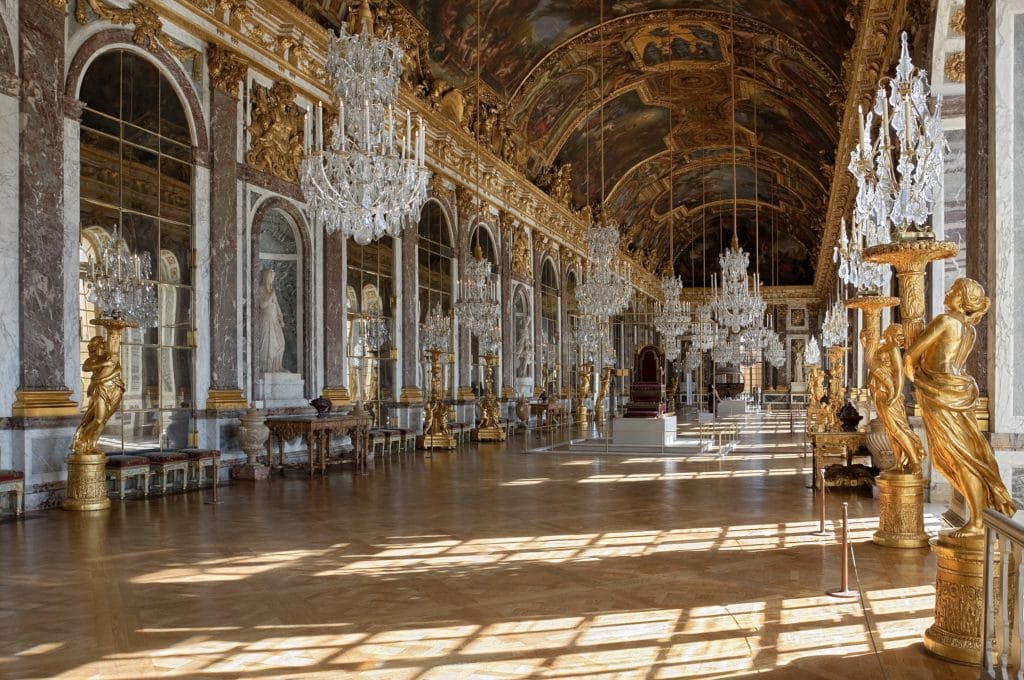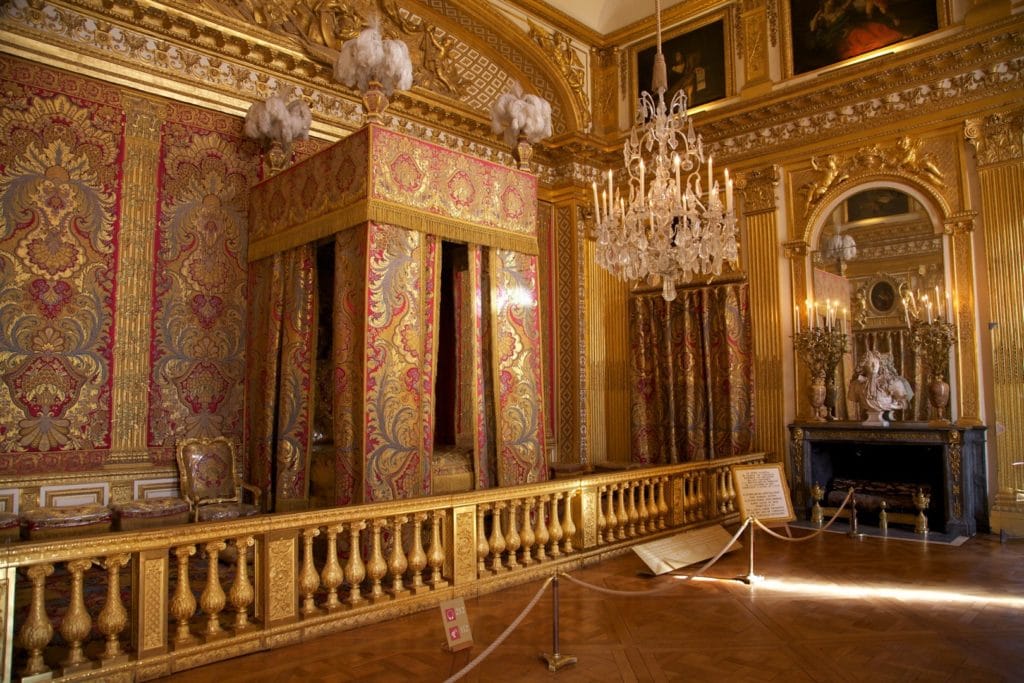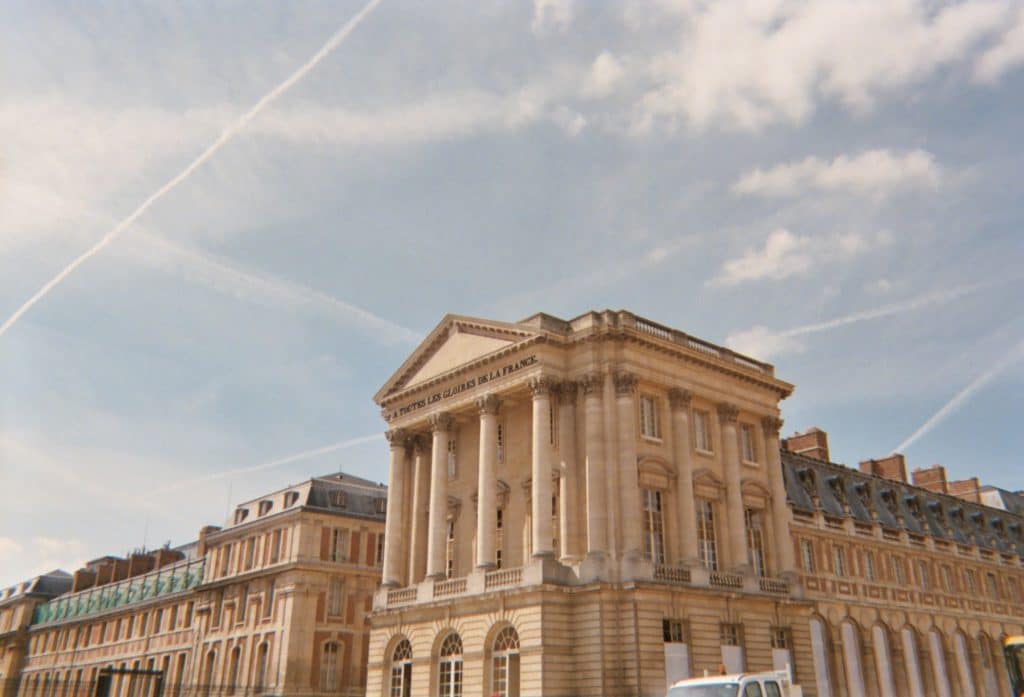Last updated on March 22nd, 2023 at 04:51 pm
The seventeenth and eighteenth centuries in Europe saw the peak of absolutism. Monarchs such as Frederick II of Prussia, Charles VI of Austria, and Peter the Great of Russia ruled with immense power over their respective kingdoms.
But it was in France where absolutism reached its zenith under Louis XIV, the Sun King. And of all the symbols of Louis’s absolutist reign, none was as grand a statement as the vast palace he had built for himself at Versailles.
The Palace of Versailles, along with the acres of gardens and deer parks around it, became the exemplary model of a European royal palace, which was never surpassed.
As a result, in future years, it would act as the scene of the creation of the German Empire in 1871 and the end of the First World War. But what was life like at Versailles?

How big was the Palace of Versailles?
The palace was built at the sight of a former royal hunting lodge about twenty kilometers outside Paris.
In 1661 King Louis XIV, who was disinclined to live in Paris as all his predecessors, wanted his royal court to remain aloof from his subjects in the capital. So, he ordered the construction of a grand new palace here.
The acclaimed Classical Baroque architect Louis Le Vau designed it. The core palace and the initial grounds took twenty years to build and plant, and it was not until 1682 that the royal court was finally moved here.

It is not hard to see why it took so long. When it was completed, the palace consisted of a three-sided building with massive wings containing over 700 apartments and 2,300 rooms.
The most extensive section was the royal wing, built around a colossal courtyard overlooking vast pleasure gardens designed by the famed French landscape architect André Le Notre.
These were heavily embellished with statues, fountains, Italian-style grottos, groves of trees, geometric flowerbeds, and even a zoo. At the same time, a large canal added an almost lake-like dimension to the Palace grounds. Beyond were deer parks for hunting.
The Social Hierarchy of Versailles
What life was like for an individual at Versailles, was determined by their status. Following the royal court’s move in the 1680s, thousands of individuals relocated to Versailles.
At the peak of this social pyramid were the king and royal family. Below them were the nobility and other courtiers, followed by hundreds of government officials and other minor courtiers.
Then there were the professional administrators who ensured everything ran smoothly in what had become a substantial town in its own right by the early eighteenth century.
Finally, below these were thousands of servants who did everything from peeling potatoes to tending the gardens. How one’s life was lived in this enormously varied set-up was determined by the station one occupied.
The Life of the Court
For the royal family, nobles, and courtiers, it isn’t an exaggeration to say that life was a continuous party. These individuals had large landed estates from which they derived substantial incomes.
Life was spent ensuring that they kept up with the latest fashions at court and attended the nearly continuous events which were held around the royal family, whether it was ambassadorial events, dances, or plays at the opera house.

Senior aristocrats were typically given apartments in the palace so that they were close to the court. Lesser courtiers might have purchased substantial houses in the town of Versailles, which had rapidly emerged nearby, or had new houses built there for their convenience so that they didn’t have to travel regularly between Versailles and Paris.
For all these clingers-on and nobles, the rhythm of life was set by the royal family. For instance, the birth of a royal prince or princess would have been an occasion of many celebrations. But as much as life at Versailles was a never-ending celebration of aristocracy, it was also a world of etiquette and never-ending routines.
Who would be a king?
No one’s life was more regimented than that of the king, whose schedule was precisely planned. He was woken at 8:30 am by a troupe of servants. After which, he rose, and a doctor and surgeon examined him.
He was then shaved and dressed, after which he consumed a light soup breakfast. About 100 servants were involved in various capacities in these morning rituals.
A formal procession through the famed Hall of Mirrors followed at 10 am. Then, between 11 am and 1 pm, the monarch would be visited by his ministers and officials concerning matters of state.
Then after a formal lunch, he might go hunting with a band of senior aristocrats and other favored courtiers in the deer parks surrounding Versailles.
Depending on how active the monarch was in government affairs, he might spend some time before dinner attending to matters of state. After that, a formal dinner was held with the royal family. However, many days in the calendar involved the more expansive court in larger festivities.
At Christmas and times of extended celebration such as following the birth of a royal heir, these could go on for days on end. At the same time, everything from a significant ambassadorial visit to the signing of a victorious peace treaty could lead to extensive celebrating.
Whatever the occasion and the scale of it, the king’s departure and return to the royal apartments for the evening was again a highly formalized affair involving dozens of servants. The king was effectively the goldfish in Versailles’s giant palatial bowl. Who would be a king?
The Life of Servants at Versaillles
The experience of most people who lived and worked around Versailles was very different. By the time Louis XIV died in 1715, the town of Versailles, lying outside the palace grounds, had expanded from nothing fifty years earlier to one of the most significant new urban centers in France with thirty thousand people living there.
The thousands of servants who were the backbone of Versailles lived in town, from the cooks to the cleaners to those who maintained the hundreds of fireplaces to keep the palace warm.

Some of these were fortunate enough to have rooms in the Grand Commun, a wing of servant quarters in the palace itself, but over time the vast majority came to live in the town of Versailles.
In the morning and evening, a visitor would have witnessed a constant stream of traffic between the palace and town in one of Europe’s first suburban commutes.
Most notably, there would have been an army of gardeners living in the town of Versailles to tend to acres of carefully laid out gardens.
Additionally, there were hundreds of skilled tradesmen and women, and artisans to cater to the many services needed at Versailles. From skilled dressmakers and seamstresses to milliners and wigmakers who made the elaborate hats and wigs worn by courtiers during the Ancien Régime, to blacksmiths to re-shoe the horses who pulled the French aristocracies’ carriages into the courtyard at Versailles.
Thus, life at Versailles was as varied as anywhere else. There were rich and poor here, and all activity on a given day.

